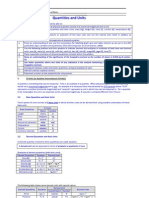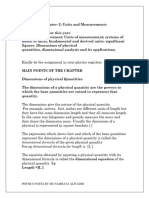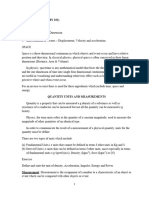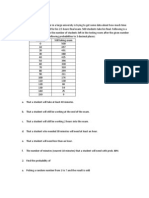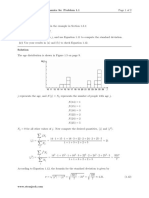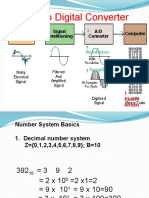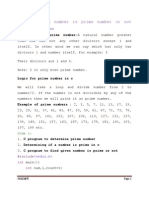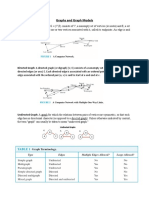1.Measurement 2021 4
1.Measurement 2021 4
Uploaded by
Tan YantingCopyright:
Available Formats
1.Measurement 2021 4
1.Measurement 2021 4
Uploaded by
Tan YantingCopyright
Available Formats
Share this document
Did you find this document useful?
Is this content inappropriate?
Copyright:
Available Formats
1.Measurement 2021 4
1.Measurement 2021 4
Uploaded by
Tan YantingCopyright:
Available Formats
9749 H2 PHYSICS; 8867 H1 PHYSICS Lecture Notes
Chapter 1
MEASUREMENT
Content
• SI Units
• Errors & uncertainties
• Scalars and vectors
Learning Outcomes
Candidates should be able to:
(a) recall the following base quantities and their SI units: mass (kg), length (m), □ □ □
time (s), current (A), temperature (K), amount of substance (mol).
(b) express derived units as products or quotients of the base units and use the □ □ □
named units listed in ‘Summary of Key Quantities, Symbols and Units’ as
appropriate.
(c) use SI base units to check the homogeneity of physical equations.
(d) show an understanding of and use the conventions for labeling graph axes and □ □ □
table columns as set out in the ASE, publication Signs, Symbols and
Systematics (The ASE Companion to 16-19 Science, 2000).
(e) use the following prefixes and their symbols to indicate decimal sub-multiples or □ □ □
multiples of both base and derived units: pico (p), nano (n), micro (µ), milli (m),
centi (c), deci (d), kilo (k), mega (M), giga (G), tera (T).
(f) make reasonable estimates of physical quantities included within the syllabus. □ □ □
(g) distinguish between scalar and vector quantities, and give examples of each. □ □ □
(h) add and subtract coplanar vectors. □ □ □
(i) represent a vector as two perpendicular components. □ □ □
(j) show an understanding of the distinction between systematic errors (including □ □ □
zero error) and random errors.
(k) show an understanding of the distinction between precision and accuracy. □ □ □
(h) assess the uncertainty in a derived quantity by addition of actual, fractional, □ □ □
percentage uncertainties or by numerical substitution (a rigorous statistical
treatment is not required).
Nanyang Junior College 1
9749 H2 PHYSICS; 8867 H1 PHYSICS Lecture Notes
I. Physical Quantities & Units
Physical quantities are measurable features of a particular item or event. Physical quantities in
physics are usually clearly and precisely defined and readily obtainable (directly or indirectly) from
measurements made in experiments.
Physical quantities can be classified as:
(a) base quantities which by agreement are treated as independent of any other quantity.
(b) derived quantities which are obtained by a simple combination of the basic quantities.
Physical quantities are usually expressed by a numerical value and a unit.
For example, speed v = 80 km h-1.
1.1 SI Base Units
A unit of measurement is a standardized amount of a physical quantity. Different systems of units
are based on different choices of a set of fundamental units.
The most widely used system of units is the International System of Units, or SI (Le Système
International d'Unités).
There are seven SI base units. All other SI units can be derived from these base units.
SI Base Unit
Base Quantity
Name Symbol
mass kilogram kg
time second s
length metre m
electric current ampere A
thermodynamic temperature kelvin K
amount of substance mole mol
luminous intensity candela cd
You may refer to APPENDIX A: DEFINITION OF SI BASE UNITS for a more detailed reading of
how physicists define a standard unit of the SI base quantity.
Nanyang Junior College 2
9749 H2 PHYSICS; 8867 H1 PHYSICS Lecture Notes
1.2 Derived Units
A derived unit is a combination of any of the seven SI base units.
Some examples of derived quantities and their corresponding units are shown.
Other SI units
Derived Quantity Derived units
Name Symbol
velocity m s-1 -- --
acceleration m s-2 -- --
density kg m-3 -- --
frequency s-1 hertz Hz
force kg m s-2 newton N
pressure kg m-1 s-2 pascal Pa
Problem Solving Skills
Set (PS3)
Method of obtaining the base units of derived quantities:
1. Write down the definition of the quantity or an equation which contains the quantity (usually
other quantities in the equation should be simpler).
2. Make the required quantity the subject in the equation.
3. Substitute the units of other quantities. Use square brackets, [ ] to express the units of a
quantity.
For example, to find base units of velocity, v
v = displacement per unit time
s
v=
t
[s ]
[=
v ] = m s-1
[t ]
Note: Do not express quantities as units in the same equation.
Nanyang Junior College 3
9749 H2 PHYSICS; 8867 H1 PHYSICS Lecture Notes
Example 1
Determine the base unit of energy, E.
Solution:
Using the equation for Gravitational Potential Energy,
E = mgh
[E ]
= [=
mgh ] kg m s=
-2
m kg m2 s-2
You may refer to APPENDIX B: SUMMARY OF KEY QUANTITIES, SYMBOLS AND UNITS for
quantities, their symbols and units that are commonly used in the study of physics.
1.3 Homogeneity of Physical Equations
In a physically meaningful expression (i.e. one that can be tested in an experiment or one that is
consistent with established theories), only quantities of the same dimension can be added or
subtracted.
as ] ( m s=
[2= )
2
Thus in the equation v=
2
u 2 + 2as , =
v 2 =
u 2 -1
m2 s-2
Such equations are said to be homogeneous or dimensionally correct. All physical equation must
necessarily be homogeneous.
Example 2
L
Check the homogeneity of the formula for the period T of a pendulum: T = 2π , where L is the
g
length and g is the acceleration due to gravity.
Solution:
LHS: [T ] = s
1
[L ] 2 m 2
1
RHS: [ 2π] = = s
[ g ] -2
m s
Since the term on the RHS has the same combination of base units as that on the LHS, the
equation is homogeneous.
Note:
1. Numerical constants such as π have no unit (i.e. they are dimensionless).
2. Some physical quantities such as refractive index and relative density cannot be expressed
in terms of base units. These are called dimensionless quantities.
3. The quantity angle, θ (= arc length / radius) is special. It is a dimensionless quantity.
However, it has been given a practical unit – radian (or degree).
Example 3
Nanyang Junior College 4
9749 H2 PHYSICS; 8867 H1 PHYSICS Lecture Notes
A hailstone of mass m falls through the air and experiences a net force F given by
F = Cv 2 – mg
where v is its speed, g is the acceleration due to gravity and C is the drag factor. Find the base
units of C.
Solution:
A valid equation has to be homogeneous. Cv 2 = [ mg ]
= [F ] =
Cv 2 [mg ] . [mg ]
Therefore, [C ] = 2
v
[F ] [=
= mg ] kg m s-2
kg m s-2
=
m2 s-2
= kg m-1
Note:
1. Equations that are not homogeneous are definitely wrong.
2. Equations that are homogeneous may or may not be correct. Possible causes of equations
that are homogeneous but are incorrect :
(i) Presence/absence of dimensionless constant
(ii) Incorrect coefficient.
(iii) Presence of extra term(s)/ Missing term(s).
1.4 Prefixes for SI Units
An SI prefix is an associated symbol that precedes a unit of measure to form a decimal multiple or
sub-multiple. SI prefixes are used to reduce the quantity of zeros in numerical equivalencies. E.g.
one-billionth of an ampere can be written as 0.000 000 001 A. Using an SI prefix, this is equivalent
to 1 nanoampere or 1 nA.
10n Prefix Symbol Name Decimal equivalent
1012 tera T Trillion 1 000 000 000 000
109 giga G Billion 1 000 000 000
106 mega M Million 1 000 000
103 kilo k Thousand 1 000
100 (none) (none) One 1
10−1 deci d Tenth 0.1
10−2 centi c Hundredth 0.01
10−3 milli m Thousandth 0.001
10−6 micro μ Millionth 0.000 001
10−9 nano n Billionth 0.000 000 001
10−12 pico p Trillionth 0.000 000 000 001
Nanyang Junior College 5
9749 H2 PHYSICS; 8867 H1 PHYSICS Lecture Notes
Example 4
Determine the equivalent value of 2.0 × 102 g cm–3 in kg m–3.
Solution:
1 g = 10-3 kg
2.0 × 102 g cm–3 = 2.0 × 102 × 10-3 kg cm–3 = 2.0 × 10-1 kg cm–3
1 cm-3 = 106 m-3
2.0 × 10-1 kg cm–3 = 2.0 × 10-1 × 106 kg m–3 = 2.0 × 105 kg m–3
1.5 Estimation of Physical Quantities
In physics the phrase 'correct to an order of magnitude' means that the value quoted is reliable to
within a factor of ten or so. It is most important for physicists to acquire a working knowledge of the
size of typical quantities. This enables them to
(i) judge the plausibility of any given quantity and
(ii) estimate the possible sizes of further quantities.
The height of a 10 storey building = 40 m
The mass of a big water melon = 5 kg
The mass of a small-sized car = 1000 kg
The frequency of radio waves = 100 MHz
The wavelength of radio waves = 3m
The separation between two atoms in solid = 10-10 m
The radius of nucleus = 10-15 m
Power of an electric kettle = 2000 W
Current in the coil of an electric kettle = 8A
Power of a filament bulb = 60 W
Current in the filament of a bulb = 0.3 A
Resistance of the filament = 700 Ω
Nanyang Junior College 6
9749 H2 PHYSICS; 8867 H1 PHYSICS Lecture Notes
Example 5
Give reasoned estimate of the acceleration of a train on the Singapore rapid transit system, giving
your answer in an SI unit.
Solution:
Top speed of train = 80 km h-1
Time to reach top speed from rest = 12 s
80 km h-1 = 22 m s-1
Acceleration = dv / dt = 22 / 12 = 1.9 m s-2 = 2 m s-2
Nanyang Junior College 7
9749 H2 PHYSICS; 8867 H1 PHYSICS Lecture Notes
II. Errors & Uncertainties
In scientific terminology measurements and readings have different meanings:
• A reading is a single determination of the value of an unknown quantity. It is the actual reading
taken during an experiment.
• A measurement is the final result of the analysis of a series of readings. A measurement is
only accurate up to a certain degree depending on the instrument used and the physical
constraints of the observer. No measurement is exact. Knowledge of the non-exactness of a
measurement is important especially when trying to define how ‘good’ or useful a certain result
is.
1.1 Definition of Error
Error is defined as the difference between an observation (either directly measured or calculated
from measurements) and the true value:
A positive error adds to the true value and makes the true value appear larger.
A negative error subtracts from the true value and makes the true value appear smaller.
e.g. if an observed value has an error of +2%, then it is 2% larger than the true value.
1.2 Types of Error
1.2.1 Systematic Error
A systematic error is one that occurs according to some fixed rule or pattern such that they
yield a consistent over-estimation or under-estimation of the true value of the measured
quantity.
Sources of Systematic Errors:
(a) Incorrect calibration of an instrument
e.g. bias caused by friction or wear in its moving parts.
(b) Construction faults in the instrument
These instrumental faults caused zero errors when the indicator or pointer of the instrument
is not at the ‘zero’ position before the start of a measurement.
(c) Non-constancy of experimental conditions
e.g. change of temperature and pressure which affects the value of the quantity measured
has not been properly taken into account.
(d) Biasness of the observer
e.g. tendency to read off a water level at the upper meniscus instead of the lower meniscus.
(e) Incorrect experimental procedure or technique
e.g. not opening the circuit after every readings when conducting electricity experiments.
Nanyang Junior College 8
9749 H2 PHYSICS; 8867 H1 PHYSICS Lecture Notes
In general, systematic errors are difficult to estimate and eliminated. They cannot be eliminated by
taking the average of repeated measurements with the same apparatus since a consistent amount
of error of the same sign is introduced in each repeated measurement. Thus systematic errors
cannot by eliminated by statistical methods eg taking average of multiple values.
However if the cause of the systematic error is known such as the zero error of a micrometer screw
gauge, steps can be taken to eliminate the error.
1.2.2 Random Error
A random error is one that occurs without a fixed pattern such that a set of measurements
done under the same conditions have an equally likely chance of being greater or less than
the true value.
Examples of random error:
(a) Random variations in external experimental conditions
e.g. random disturbances caused by mechanical vibrations, tremors produced by the wind
(b) Non-constancy of experimental specimen
e.g. non-uniform diameter of cylindrical specimen
(c) Random human error
e.g. misjudgment in the interpolation of the smallest division of the scale of measuring
instruments
Since random errors have an equal probability of being positive or negative, it can be reduced by
taking a large number of independent readings of a quantity. Their mean or average is then almost
entirely free from random errors and gives the best estimate for the value of the quantity being
measured.
Nanyang Junior College 9
9749 H2 PHYSICS; 8867 H1 PHYSICS Lecture Notes
1.2.3 Distinction between Random Errors and Systematic Errors
true value true value
Figure 1 Figure 2
Fig. 1 Fig. 2
If there are only random errors present in the experiment and the measurement of a physical
quantity is repeated 5 times under the same conditions, then the 5 measured values will be spread
about the true value: some will be too high and others too low as shown in Fig. 1.
If in addition to the random errors, there is also a systematic error, then the 5 measured values will
be spread, not about the true value, but about some displaced value as shown in Fig. 2.
1.3 Measures of Error
Precision and accuracy are often taken to mean the same thing. However in physics, we do not
equate the term ‘precision’ with ‘accuracy’.
1.3.1 Accuracy
Accuracy refers to how closely a measured value agrees with the ‘true’ value.
It is associated with the systematic error of the measurement process and thus it is dependent on
how well we can control or compensate for systematic errors. A measurement that is relatively free
of systematic error is said to be accurate.
For example, an experiment was conducted to determine the value of g (acceleration due to gravity)
and the results in m s-2 that turned out as follows:
9.853, 9.921, 9.793, 9.677, 9.818
The results are fairly accurate (close to 9.81). The average of the five accurate measurements is
9.8 with a spread of about ± 0.1.
Nanyang Junior College 10
9749 H2 PHYSICS; 8867 H1 PHYSICS Lecture Notes
1.3.2 Precision
Precision refers to how closely individual measurements agree with each other without
reference to any ‘true’ value.
It is associated with the random errors of the measurement process and hence it is dependent on
how well we can overcome random errors. The smaller the spread of the measurements, the more
precise the measurement is said to be. In other words, a series of measurements is said to be
precise if the random error involved is small.
Using the same example as in 1.3.1, another attempt of the same experiment produced the
following results:
9.652, 9.654, 9.642, 9.644, 9.660, 9.666
The average of the six measurements is 9.65 with a spread of about ± 0.02. Though it may be far
from the expected (or true) value of 9.81, it is a very precise measurement.
Example 1
Which of the following diagrams have 5 readings which are
(i) precise but not accurate and, (B)
(ii) accurate but not precise (A)
(iii) both accurate and precise. (C)
A. B.
true value
true value
C. D.
true value true value
Nanyang Junior College 11
9749 H2 PHYSICS; 8867 H1 PHYSICS Lecture Notes
Example 2
In the following table the left column contains descriptors of the concepts of random error,
systematic error, accuracy and precision. Fill in the correct concepts that are being described in
the right column.
Description Concept
has definite causes systematic error
has nonspecific causes random error
is a measure of correctness accuracy
is a measure of reproducibility precision
is not reproducible random error
is reproducible systematic error
leads to poor accuracy systematic error
leads to poor precision random error
1.4 Definition of Uncertainty
Uncertainty is an estimate of systematic and/ or random errors inherent in the measurement or
calculation.
Since one can never be 100% certain that the reading taken is the true value of the measured
quantity, we cannot say what the actual error is. As the error is often unknown and uncertainty is
an estimate of it, the terms ‘error’ and ‘uncertainty’ are often used interchangeably.
1.4.1 Absolute Uncertainty
Absolute uncertainty or absolute error indicates the magnitude of the uncertainty in a quantity in
the same units. For the quantity X,
Absolute uncertainty = ∆X
The absolute uncertainty of a measured quantity using an analogue scale is usually associated
with the smallest division or fraction of the smallest division (if the spacing is large) If a digital
display instrument is used, then the absolute uncertainty is associated with the least decimal place
or reasonable estimate.
Absolute uncertainty of a quantity is always expressed in 1 significant figure as it represents the
variability of the quantity.
Nanyang Junior College 12
9749 H2 PHYSICS; 8867 H1 PHYSICS Lecture Notes
For example, if length L is calculated to be 3.243 cm with an absolute uncertainty of ± 0.01 cm,
L with its uncertainty would be expressed as L = (3.24 ± 0.01) cm
1.4.2 Fractional Uncertainty
Fractional uncertainty is the uncertainty of a quantity expressed as a fraction of the quantity.
∆X
Fractional uncertainty =
X
∆L 0.01
Using the previous example the fractional uncertainty is = ± 0.0031 or ± 3.1× 10 −3
=
L 3.24
Note: Fractional uncertainty need not be expressed as 1 significant figure unlike absolute
uncertainty.
1.4.3 Percentage Uncertainty
Percentage uncertainty is the fractional uncertainty multiplied by 100% to express the fraction as a
percentage.
∆X
Percentage uncertainty = .100%
X
Using the previous example the percentage uncertainty in L is
∆L 0.01
× 100% =× 100% =
± 0.31%
L 3.24
Problem Solving Skills
Set (PS3)
Rules in Recording Uncertainty
1. Make the required quantity the subject in the equation.
2. Substitute values to determine its magnitude.
3. Find the absolute uncertainty and round off to 1 significant figure.
4. The quantity should be rounded so that it has the same number of decimal places or
places as the absolute uncertainty.
For example, if t is measured to be 12.34 s with an uncertainty of ± 0.2 s, t should be
expressed as t = (12.3 ± 0.2) s
5. When the quantity is given in standard form, the uncertainty should be given in standard form
with the same power of ten.
For example, instead of writing t = (1.43 × 106 ± 2 × 104) s, express it as
t = (1.43 ± 0.02) × 106 s
Nanyang Junior College 13
9749 H2 PHYSICS; 8867 H1 PHYSICS Lecture Notes
Example 3
Express the following results in proper rounded form, x ± ∆x.
(i) t = 0.02346 s, ∆t = 1.623 × 10-3 s
1. Round ∆t off to 1 significant figure: ∆t = 2 × 10-3 s
2. Round t to the same number of decimal places or same places as ∆t: t = 0.023 s
3. Express t in standard form and express ∆t in the same power of ten as t
t = 2.3 × 10-2 s and ∆t = 0.2 × 10-2 s
4. Express in the form (t ± ∆t): (2.3 ± 0.2) × 10-2 s
(ii) z = 25432.3 m, ∆z = 534.1 m
z ± ∆z = (2.54 × 104 ± 5 × 102) m ⇒ z = (2.54 ± 0.05) × 104 m
(iii) m = 9.1152 × 1022 kg, ∆m = 2.6 × 1019 kg
m ± ∆m = (9.115 × 1022 ± 3 × 1019) kg ⇒ m = (9.115 ± 0.003) × 1022 kg
1.5 Combining Uncertainties
The final result of an experiment is seldom obtained by a single measurement. When a quantity Z
is calculated using two measured quantities X and Y having uncertainties ∆X and ∆Y respectively,
it inherits its uncertainty from X and Y.
1.5.1 Set of values
For a set of values of X, the average or mean of this set of X values is calculated and the range of
this set of X values (difference between the maximum and minimum x value) is also calculated.
The absolute uncertainty of X is then estimated to be half of this range.
Nanyang Junior College 14
9749 H2 PHYSICS; 8867 H1 PHYSICS Lecture Notes
Example 4
An experiment was conducted to determine the value of g (acceleration due to gravity) and the
results in m s-2 that turned out as follows:
9.853, 9.921, 9,793, 9.677, 9.818
Determine g and its uncertainty.
Solution:
<g> = 9.812 m s-2
Range = 9.921 – 9.677 = 0.244 m s-2
Absolute uncertainty = 0.244 / 2 = 0.1 m s-2 (corrected to 1 s.f.)
Hence g = (9.8 ± 0.1) m s-2
1.5.2 Addition and Subtraction
If Z = X + Y or Z = X - Y, the uncertainty of Z is given by
∆Z = (∆X + ∆Y)
1.5.3 Quantity multiplied by a constant
If a reading is multiplied by a constant k, the uncertainty is also multiplied by k.
Z = kX ⇒ ∆Z = k∆X
Note: Although the uncertainty itself has changed by k times, the fractional uncertainty and
percentage uncertainty remains the same.
In general, if Z = nX ± mY, where n and m are constants then
∆Z = n∆X + m∆Y
Example 5
The radius of a circle is x = (5.0 ± 0.1) cm. Find the circumference and its uncertainty.
Solution:
Circumference, C = 2πr = 2π (5.0) = 31.42 cm
∆C = 2π (∆x) = 2π (0.1) = ± 0.6 cm (1 sig. fig.) ⇒ C = (31.4 ± 0.6) cm
Nanyang Junior College 15
9749 H2 PHYSICS; 8867 H1 PHYSICS Lecture Notes
Example 6
A student uses a stopwatch, which has an uncertainty of ± 0.2 s, to time 20 oscillations of a
pendulum bob. The time recorded t is 38.5 s. Determine the period T and its uncertainty.
Solution:
1 1 1 1
=
T = t = 1.925 s ; ∆T=
(38.5) ( ∆t )= (0.2)= 0.01 s ∴=
T (1.93 ± 0.01) s
20 20 20 20
1.5.4 Multiplication and Division
If Z = XY or Z = X/Y, then the consequential uncertainty is given by
∆Z ∆X ∆Y
= +
Z X Y
Example 7
In a circuit, that current through the resistor, I = (1.14 ± 0.01) A and the potential difference across
it, V = (2.25 ± 0.05) V. Determine the power dissipated, P, by the resistor and its uncertainty.
Solution:
P = IV = 1.14 × 2.25 = 2.565 W (Do not round off at this stage!)
∆P ∆I ∆V
= +
P I V
∆I ∆V 0.01 0.05
∆P = I + V P =
1.14 + 2.25 (2.565) =± 0.08 W (corrected to 1 sig. fig.)
Therefore, P = (2.57 ± 0.08) W
1.5.5 Quantity raised to power n
If Z = Xn or Z = X-n then
∆Z ∆X
=| n |
Z X
nX α
In general, if Z = nXα.mYβ or Z = , where n, m, α and β are constants, then
mY β
∆Z ∆X ∆Y
= α +β
Z X Y
Nanyang Junior College 16
9749 H2 PHYSICS; 8867 H1 PHYSICS Lecture Notes
Example 8
Use the following readings and formula to determine the resistivity of the wire in the form of (ρ ±
∆ρ).
π ρ 2R
Resistivity, ρ =
L
Length L of the wire = (10.0 ± 0.1) cm
Radius r of the wire = (0.28 ± 0.01) mm
Resistance R of the wire = (2.00 ± 0.05) Ω
Solution:
π r 2R π (0.28 × 10−3 )2 (2.00)
r= = = 4.926 × 10 −6 Ω m
L 10.0 × 10 −2
∆r ∆R ∆L
∆
=rr 2 r + R + L
0.01 0.05 0.1 −6
= 2 + 2.00 + 10.0 (4.926 × 10 )
0.28
5 × 10−7 Ω m
=
=0.5 × 10 −6 Ω m
Therefore the resistivity of the wire is (4.9 ± 0.5) × 10-6 Ω m.
1.5.6 Quantity with mathematical function
For mathematical function such as trigonometric function of a reading, we can estimate the error as
being the difference of the average value with either the smallest or largest possible value.
ΔZ = Z – Zmin or ΔZ= Zmax – Z
Consider Z = sin θ where θ = 48° ± 3°,
Z = sin 48° = 0.743
Using the smallest and largest possible value of θ,
Zmin = sin 45° = 0.707
Zmax = sin 51° = 0.777
Z – Zmin = 0.743 – 0.707 = 0.036
Zmax - Z = 0.777 – 0.743 = 0.034
(choose the larger of the two)
Therefore, ΔZ= 0.036 = 0.04 (1 s.f.)
Z ± ΔZ = 0.74 ± 0.04
Nanyang Junior College 17
9749 H2 PHYSICS; 8867 H1 PHYSICS Lecture Notes
III. Scalars and Vectors
1.1 Scalar Quantities
A scalar is a quantity which has magnitude only.
It does not have direction. The magnitude is a value more/less than a reference value.
Scalars can be added or subtracted just like integers.
Examples of scalars include mass, time, length, volume, temperature, density, speed, energy,
pressure and current.
Example 1
Convert the temperature of the boiling point of nitrogen, 77.30 K, to a temperature on the Celsius
scale.
θ = T - 273.15 = 77.30 - 273.15 = -195.85 oC
1.2 Vector Quantities
A vector is a quantity which has both magnitude and direction.
Unlike scalars, vectors cannot simply be added like integers. See Section 1.4 Addition of Vectors.
Examples of vectors include displacement, velocity, acceleration, moments, force, momentum and
gravitational field strength.
1.3 Vector Representation
A vector can be denoted by a letter in bold, e.g. force F, or F or F. Its magnitude (absolute value) is
~
denoted by either F , F , or | F |.
~
A vector can be represented in a diagram by a line segment with its length representing the
magnitude and its direction shown by an arrow.
Scale 1 cm : 5 N
F
30° x - axis
In the above diagram the force F is _20___ N and is in the direction 30° above the x-axis.
Nanyang Junior College 18
9749 H2 PHYSICS; 8867 H1 PHYSICS Lecture Notes
1.3.1 Equal vectors
Two vectors are said to be equal if they have the same magnitude and direction (parallel). In the
figure below, P, Q and R are equal vectors i.e. P = Q = R.
1.3.2 Negative vectors
The negative of a vector is defined as a vector of the same magnitude but opposite in direction
(antiparallel).
-S
1.3.3 Scalar multiplication of vectors
If vector T is multiplied by a positive scalar k (where k > 0), the product kT is a vector that has the
same direction as T with magnitude k T .
2T
If vector U is multiplied by a negative scalar - k (where k > 0), the product - kU is a vector that has
a direction opposite to that of U and magnitude k U .
1
− U
2
Nanyang Junior College 19
9749 H2 PHYSICS; 8867 H1 PHYSICS Lecture Notes
1.4 Vector Addition
The addition of two vectors P and Q yields another vector which is known as the resultant R (or
vector sum R), and is written as P + Q = R.
Vector addition obeys:
(i) commutative law, i.e. A + B = B + A
(ii) associative law, i.e. (A + B) + C = A + (B + C)
1.4.1 Addition of Parallel/Antiparallel Vectors
Two or more vectors having the same/opposite direction can be added using simple addition.
Example 2
Find the resultant force acting on the box in the given diagram. 5N
3N
Taking right to be positive direction, 10 N
Fresultant = 5 + 10 + (− 3 )
= 12 N
The resultant force is 12 N towards the right.
1.4.2 Addition of Two Non-Parallel Vectors
Two non-parallel vectors can be added using either the
(i) parallelogram of vectors, or the
(ii) triangle of vectors.
Let A and B be two non-parallel vectors given as below.
A
B
To find the sum of the two vectors, C where A + B = C,
Nanyang Junior College 20
9749 H2 PHYSICS; 8867 H1 PHYSICS Lecture Notes
Method 1: Triangle Method
The tail of B is drawn to the tip (head) of A (or vice versa, commutative law). The vector sum C is
the vector from the tail of A to the tip of B.
B
A + = A C
B
Method 2: Parallelogram Method
Both vectors are drawn from a common point. The vector sum C is the diagonal of the
parallelogram of which the given vectors form two sides.
A + =
A C
B
B
1.4.3 Calculation of Resultant Vector
There are four approaches for computing resultant vector.
(i) Accurate (large) scale drawing
(ii) Pythagoras’ theorem
(iii) Sine and cosine rule
(iv) Resolution and addition of (perpendicular) vectors
Nanyang Junior College 21
9749 H2 PHYSICS; 8867 H1 PHYSICS Lecture Notes
Method 1: Scale Drawing
Example 3
A car travels 10 km in the north-east direction, followed by 5 km in the south direction. Using an
appropriate scale diagram, find the displacement of the car.
Using a scale of 1 cm : 1 km
5 km
10 km
45°
16°
From diagram, displacement of the car is 7.4 km 16° north of east.
Note: In general do not use this method of scale drawing in problem-solving, unless specifically
asked to do so by the question.
Nanyang Junior College 22
9749 H2 PHYSICS; 8867 H1 PHYSICS Lecture Notes
Method 2: Pythagoras’ Theorem (only for perpendicular vectors)
When two vectors are perpendicular to each other, their resultant magnitude can be determined
using Pythagoras’ Theorem.
Example 4
The maximum speed that a motor boat can travel in still water is 10.0 m s-1. Suppose it is crossing
the river perpendicular to the river bank at the maximum speed, and the water flows parallel to the
river bank at 2.0 m s-1. Find the resultant velocity of the boat.
vB = 10.0 m s-1 Direction of water flow
vw = 2.0 m s-1
Top view vW
Using Pythagoras’ theorem, vB
v resultant = v B + v w
2 2 2 vresultant
v resultant = 10.0 2 + 2.0 2
= 10.2
θ
vw
tan θ =
vB
2 .0
θ = tan −1
10.0
= 11.3°
Resultant velocity of the boat is 10.2 m s-1 11.3° from the perpendicular to the river bank.
Method 3: Sine and Cosine Rule (for non-perpendicular vectors)
When two vectors are not perpendicular to each other, their resultant vector can be determined
using both sine and cosine rule.
Cosine Rule B
α
2 2 2 A γ
C = A + B − 2 A B cos γ
β C
Sine Rule
A B C
= =
sin α sin β sin γ
Nanyang Junior College 23
9749 H2 PHYSICS; 8867 H1 PHYSICS Lecture Notes
Example 5
Solve example 3 using sine and cosine rule. N
Using cosine rule, 45°
s = 10 + 5 − 2(10 )(5 ) cos 45°
2 2 2
5 km
s = 7.37 10 km
Using sine rule,
sin θ sin 45°
=
5 s 45°
5 sin 45° θ s
sin θ = α
7.37
θ = 28.7°
α = 90° − 45° − θ
= 16.3°
Displacement of the car is 7.37 km 16.3° north of east.
Method 4: Resolution and addition of Vectors
This is a general method for adding non-perpendicular vectors. Vectors are first resolved into two
perpendicular components and then added vectorially using the Pythagoras’ theorem. This method
is particular useful for vector addition of more than two vectors.
1.5 Resolution of Vectors
Recall that two vectors A and B can be added to yield the resultant vector C (refer to 1.4.2). In the
same way a single vector C can also be considered to be the resultant of many other two vectors,
e.g. C = A + B or C = P + Q or C = X + Y.
C
B
A C Q
P
C=A+B C=P+Q
Nanyang Junior College 24
9749 H2 PHYSICS; 8867 H1 PHYSICS Lecture Notes
C
Y
C=X+Y
Any two vectors whose vector sum equals a vector are called the components of that vector. The
vectors A and B, P and Q, as well as X and Y, are the components of the vector C.
In fact there is infinite number of pairs of possible vectors that add up to give the vector C.
However, it is often useful to resolve a vector into two perpendicular components, as
perpendicular vectors are independent.
For example the vector C can be resolved (i.e. ‘split up’) into its components, Cx and Cy, along the
x - and y - axes.
C x = C cosθ
C
Cy C y = C sinθ
θ
Cx
C = Cx + Cy
Example 6
Find the components of an applied force F acting on a trolley along the vertical and horizontal
directions.
Let the horizontal component of F be Fx and vertical component be Fy,
Fx = F cos θ F = 15 N
= 15 cos 24°
= 13.7 N
θ = 24o
Fy = F sin θ
= 15 sin 24°
= 6.10 N
Nanyang Junior College 25
9749 H2 PHYSICS; 8867 H1 PHYSICS Lecture Notes
Example 7
Express, in terms of θ and W, the component of the weight W acting on the block placed on a
slope as shown,
(i) along the slope, and
(ii) perpendicular to the slope.
W//
Resolving W along slope, θ θ
W // = W sinθ
Resolving W perpendicular to slope,
W ⊥ = W cos θ W⊥
W
Example 8
Three forces F1, F2 and F3 act on a ball. Find the resultant of the forces acting on the ball.
Let the horizontal component of the resultant force be Fx.
Taking right to be positive direction, F1 = 15.0 N
y - axis
Fx = F1 cos 53° − F3 sin 32°
= 15.0 cos 53° − 20.0 sin 32°
= −1.57 N F2 = 8.0 N
53°
x - axis
Let the vertical component of the resultant force be Fy.
Taking up to be positive direction, 32°
Fy = F1 sin 53° + F2 − F3 cos 32°
= 15.0 sin 53° + 8.0 − 20.0 cos 32°
= 3.02 N
F = Fx + Fy
2 2 F3 = 20.0
| Fy |N
= (− 1.57 )2 + (3.02)2
= 3.40 N
Fy
tanθ = θ
Fx
| Fx |
θ = 62.5°
Resultant force is 3.40 N, 62.5° above negative x-axis.
Nanyang Junior College 26
9749 H2 PHYSICS; 8867 H1 PHYSICS Lecture Notes
1.6 Vector Subtraction
To subtract a vector Q from P is equivalent to adding the negative of Q to P, i.e. P - Q = P + (- Q).
- Q = + -Q
P P
= P-Q -Q
1.7 Change in Quantity
The change in a quantity (scalar or vector), ∆V, is given by the difference between the final quantity
Vf and the initial quantity Vi, i.e.
∆V = Vf – Vi
Example 9
A balloon is heated and its volume increases from 1000 cm3 to 1200 cm3. Determine the change in
volume of the balloon.
Change in volume = Final volume − Initial volume
∆V = Vf − Vi
= 1200 − 1000
= 200 cm 3
The volume of the balloon has increased by 200 cm3.
Nanyang Junior College 27
9749 H2 PHYSICS; 8867 H1 PHYSICS Lecture Notes
Example 10
(a) A car travelling in a circle changes its speed from 50 km h-1 North to 30 km h-1 East.
Determine the change in speed of the car.
Change in speed = Final speed - Initial speed
∆v = v f - v i
= 30 - 50
= -20 km h -1
Food for thought: What does the negative sign of the above quantity represent?
Speed is a scalar quantity. The negative sign represents a decrease in the speed of the car.
(b) A car travelling in a circle changes its velocity from 50 km h-1 North to 30 km h-1 East.
Determine the change in velocity of the car.
30 km h-1
Change in velocity = Final velocity − Initial velocity
∆v = v f − v i θ
= -
∆v = 30 + 50
2 2 2
50 km h-1
∆v = 58.3 km h -1 ∆v
50 = +
tan θ =
30
θ = 59.0°
Change in velocity is 58.3 km h-1 59.0° South of East.
Nanyang Junior College 28
9749 H2 PHYSICS; 8867 H1 PHYSICS Lecture Notes
Example 11
A particle has an initial velocity of 15 m s-1 in the x direction, as shown. At a later time its velocity is
15 m s-1 at an angle of 60° to x. Determine the change of velocity that has taken place in this
interval.
15 m s-1
60°
-1
x 15 m s
Change in velocity = Final velocity − Initial velocity
∆v = v f − v i
= -
= +
15 m s-1
60°
∆v = 15 m s -1 (equilateral ∆ )
Change in velocity is 15 m s-1 120° from direction of x. ∆v 15 m s-1
Nanyang Junior College 29
9749 H2 PHYSICS; 8867 H1 PHYSICS Lecture Notes
APPENDIX A: DEFINITION OF SI BASE UNITS
Base Quantity Base Unit Symbol Definition
The unit of length is equal to the length of the path
length metre m traveled by light in vacuum during the time interval of
1/299 792 458 of a second.
The unit of mass is equal to the mass of the international
prototype kilogram (a platinum-iridium cylinder) kept at
mass kilogram kg
the Bureau International des Poids et Mesures (BIPM),
Sèvres, Paris.
The unit of time is the duration of exactly 9 192 631 770
periods of the radiation corresponding to the transition
time second s
between two hyperfine levels of the ground state of the
caesium-133 atom at a temperature of 0 K.
The unit of electrical current is the constant current
which, if maintained in two straight parallel conductors, of
electrical
ampere A infinite length and negligible cross-section, placed 1 m
current
apart in a vacuum, would produce a force between these
conductors equal to 2 × 10−7 N per metre of length.
thermodynamic The unit of thermodynamic temperature (or absolute
temperature kelvin K temperature) is the fraction 1/273.16 (exactly) of the
thermodynamic temperature at the triple point of water.
A mole is the quantity of substance that contains the
same number of elementary entities (atoms, molecules,
amount of ions, electrons or particles, depending on the substance)
mole mol
substance as there are atoms in 0.012 kg of pure carbon-12; this
number (NA) is approximately equal to 6.02214199 ×
1023.
The unit of luminous intensity is the luminous intensity, in
a given direction, of a source that emits monochromatic
luminous
candela cd radiation of frequency 540 × 1012 Hz and that has a
intensity
radiant intensity in that direction of 1/683 watt per
steradian.
Further reading
http://www.nature.com/news/kilogram-conflict-resolved-at-last-1.18550
http://www.livescience.com/26017-kilogram-gained-weight.html
Nanyang Junior College 30
9749 H2 PHYSICS; 8867 H1 PHYSICS Lecture Notes
APPENDIX B: SUMMARY OF KEY QUANTITIES, SYMBOLS AND UNITS
Quantity Usual symbols Usual unit Quantity Usual symbols Usual unit
Base Quantities angular frequency ω rad s
-1
speed of
mass m kg -1
electromagnetic waves c ms
length l m
electric charge Q C
time t s
elementary charge e C
electric current I A
electric potential V V
thermodynamic
electric potential
temperature T K
difference V V
amount of substance n mol
electromotive force E V
Other Quantities resistance R Ω
resistivity ρ Ωm
distance d m -1 -1
electric field strength E NC ,Vm
displacement s, x m
2
permittivity of free
area A m space ε0 Fm
-1
3
volume V, v m magnetic flux Φ Wb
density ρ kg m
-3
magnetic flux density B T
-1
speed u, v, w, c ms permeability of free
velocity u, v, w, c ms
-1
space µo Hm
-1
-2 -1
acceleration a ms force constant k Nm
acceleration of free fall g ms
-2
Celsius temperature θ °C
-1 -1
force F N specific heat capacity c J K kg
-1 -1
weight W N molar gas constant R J K mol
-1
momentum p Ns Boltzmann constant k JK
-1
work w, W J Avogadro constant NA mol
energy E, U, W J number N, n, m
potential energy Ep J number density
(number per unit
kinetic energy Ek J -3
volume) n m
heating Q J
Planck constant h Js
change of internal
energy ΔU J work function energy Φ J
activity of radioactive
power P W
source A Bq
pressure p Pa
decay constant λ s
-1
torque T Nm
-2 2 half-life t1/2 s
gravitational constant G N kg m
relative atomic mass Ar
gravitational field
-1 relative molecular mass Mr
strength g N kg
gravitational potential φ J kg
-1 atomic mass ma kg, u
angle θ °, rad electron mass me kg, u
angular displacement θ °, rad neutron mass mn kg, u
proton mass mp kg, u
angular speed ω rad s
-1
molar mass M kg
angular velocity ω rad s
-1
proton number Z
period T s
nucleon number A
frequency f Hz
neutron number N
Nanyang Junior College 31
You might also like
- Grade 10 Physics Student's BookDocument142 pagesGrade 10 Physics Student's BookJames Soe89% (19)
- Chapter 1 Physical Quantities and UnitsDocument37 pagesChapter 1 Physical Quantities and UnitsTutor_KLNo ratings yet
- I - Year-Success Key Notes-2023-2024Document22 pagesI - Year-Success Key Notes-2023-2024Gangadhara CNo ratings yet
- 1 - Physical Quantities and UnitsDocument19 pages1 - Physical Quantities and UnitsJunHang GehNo ratings yet
- As Level Physics 2011 Smak Gs Kbi MeasurementDocument13 pagesAs Level Physics 2011 Smak Gs Kbi MeasurementJoshuaUntungNo ratings yet
- 1730789005Document43 pages1730789005manishkumar9112007No ratings yet
- Section 1. 0 Physical Quantities and UnitsDocument140 pagesSection 1. 0 Physical Quantities and Unitsgarikaishumba2005No ratings yet
- Lecture Notes On PHY 101Document7 pagesLecture Notes On PHY 101Ezenwaka Eucharia100% (3)
- Measurement Whole ChapterDocument22 pagesMeasurement Whole Chaptersamridhikohli21No ratings yet
- Topic 1 Physical Quantities and Units PPT Student 2022Document30 pagesTopic 1 Physical Quantities and Units PPT Student 2022Joanne LeeNo ratings yet
- Physical QuantitiesDocument5 pagesPhysical Quantitiesstantk28No ratings yet
- Phy 433 Chapter 1Document24 pagesPhy 433 Chapter 1Treesis BondNo ratings yet
- PHY433 Chapter 1Document30 pagesPHY433 Chapter 1HANY NUR AQILAH YUSOFNo ratings yet
- TOPIC 1: Units, Trigonometry, and Vectors: Madam Nur Asyikin Binti Ahmad Nazri +60 0135853632 Asyikin2750@uitm - Edu.myDocument35 pagesTOPIC 1: Units, Trigonometry, and Vectors: Madam Nur Asyikin Binti Ahmad Nazri +60 0135853632 Asyikin2750@uitm - Edu.myKhairun HusnaNo ratings yet
- HydraulicsDocument76 pagesHydraulicsJeffrey BeloyNo ratings yet
- Phy 101 Note 22-23Document8 pagesPhy 101 Note 22-23Aye OyemamiNo ratings yet
- PHY 101 Lecture NoteDocument42 pagesPHY 101 Lecture Notemiracle godfreyNo ratings yet
- Units & DimensionsDocument6 pagesUnits & DimensionsRaju SinghNo ratings yet
- General Physics 1 BiologyDocument9 pagesGeneral Physics 1 Biologyahmed134ahmed123No ratings yet
- As Chapter 1 Physical Quantities and UnitsDocument50 pagesAs Chapter 1 Physical Quantities and Unitskwaikun100% (2)
- H2 Measurement 2012Document21 pagesH2 Measurement 2012Ronnie QuekNo ratings yet
- 2.01 SI UnitsDocument6 pages2.01 SI UnitsParveen JonesNo ratings yet
- 2 Units MeasurementsDocument3 pages2 Units MeasurementspeddapallipurandeeswarNo ratings yet
- COURSE SYNOPSIS and CHAPTER 1 (Physical Quantities,Unit & Dimension)-1Document7 pagesCOURSE SYNOPSIS and CHAPTER 1 (Physical Quantities,Unit & Dimension)-1hunjamaayeNo ratings yet
- Chapitre1 - Rappels-Mathématiques enDocument23 pagesChapitre1 - Rappels-Mathématiques enwaoulamalNo ratings yet
- 1 - Physical Quantities and MeasurementsDocument49 pages1 - Physical Quantities and MeasurementsPunitha Marimuthoo100% (1)
- PHY 102 - Wk2SlidesDocument11 pagesPHY 102 - Wk2Slidesrajiaishat69No ratings yet
- Lecture 1 - Physical Quantities and Units in PhysicsDocument14 pagesLecture 1 - Physical Quantities and Units in PhysicsKAPEMBWA MAPALONo ratings yet
- Physics Full Lecture Notes (2021)Document193 pagesPhysics Full Lecture Notes (2021)aaronlungutsgNo ratings yet
- Ch. 2Document6 pagesCh. 2Sandy ShohdyNo ratings yet
- Chapter 1 Physical Quantities and MeasurementsDocument17 pagesChapter 1 Physical Quantities and Measurements陈康德No ratings yet
- General Physics (Phy 101)Document6 pagesGeneral Physics (Phy 101)Adewale Peter OlowatosinNo ratings yet
- CLASS 11 (Holiday Homework)Document6 pagesCLASS 11 (Holiday Homework)ry612892No ratings yet
- Physics 1Document143 pagesPhysics 1neeraj0107100% (1)
- Hydraulic Similitude and Mode LanalysisDocument78 pagesHydraulic Similitude and Mode LanalysisEng-Mohamed Hashi100% (1)
- Ib Academy - nl+Physics+SL 1Document100 pagesIb Academy - nl+Physics+SL 1AliceNo ratings yet
- MasteringPhysics Dimensions of Physical QuantitiesDocument3 pagesMasteringPhysics Dimensions of Physical QuantitiesPratik LtdNo ratings yet
- Taller de Autoaprendizaje No 1a PDFDocument100 pagesTaller de Autoaprendizaje No 1a PDFGerman Rincon UrregoNo ratings yet
- Practice Paper - Question Bank - Units DimensionsDocument4 pagesPractice Paper - Question Bank - Units DimensionsRahil YTNo ratings yet
- SF017 CH 1 Physical QuantitiesDocument88 pagesSF017 CH 1 Physical QuantitiessureinrajahNo ratings yet
- Dimensions PDFDocument25 pagesDimensions PDFMspamNo ratings yet
- Units and DimensionsDocument21 pagesUnits and DimensionsThe DivineNo ratings yet
- Best Mechanics PaupletDocument144 pagesBest Mechanics Paupletr241659aNo ratings yet
- Introduction To Physics 1 PDFDocument27 pagesIntroduction To Physics 1 PDFjgd2080No ratings yet
- Introduction To Physics Grade 12Document56 pagesIntroduction To Physics Grade 12RainCNo ratings yet
- Dimensional Analysis Part 1 v3Document7 pagesDimensional Analysis Part 1 v3tahadostmushtaqNo ratings yet
- Mathematical Tripos: at The End of The ExaminationDocument27 pagesMathematical Tripos: at The End of The ExaminationDedliNo ratings yet
- I - Year-Success Key Notes-2023-2024Document42 pagesI - Year-Success Key Notes-2023-2024srishti.intlNo ratings yet
- Mechanics Module by PetrosDocument10 pagesMechanics Module by PetrosPetros JereNo ratings yet
- UNSW-skills in Experimentation Workbook1Document59 pagesUNSW-skills in Experimentation Workbook1arun.rajayoganNo ratings yet
- 1-2 SI Prefixes and UnitsDocument28 pages1-2 SI Prefixes and UnitsHefeyNo ratings yet
- Physical Science C0601: Name: ClassDocument12 pagesPhysical Science C0601: Name: ClassCenando BodanioNo ratings yet
- Unit & DimensionDocument75 pagesUnit & DimensionVipin ChoudharyNo ratings yet
- 1 - Units and DimensionsDocument20 pages1 - Units and Dimensionsrnqmmsm4hgNo ratings yet
- Dimensional Analysis: CN2122 / CN2122EDocument31 pagesDimensional Analysis: CN2122 / CN2122EGermaine LuahNo ratings yet
- Barron's Physics Practice Plus: 400+ Online Questions and Quick Study ReviewFrom EverandBarron's Physics Practice Plus: 400+ Online Questions and Quick Study ReviewNo ratings yet
- Student Solutions Manual to Accompany Economic Dynamics in Discrete Time, second editionFrom EverandStudent Solutions Manual to Accompany Economic Dynamics in Discrete Time, second editionRating: 4.5 out of 5 stars4.5/5 (2)
- OR 7th Sem NIT Raipur QPaperDocument37 pagesOR 7th Sem NIT Raipur QPaperShashi Bhushan PatelNo ratings yet
- Psu Math Relays Logic & Set Theory 2017Document6 pagesPsu Math Relays Logic & Set Theory 2017ARNAV ARNAVNo ratings yet
- 1 Microcontroller Instruction SetDocument72 pages1 Microcontroller Instruction SetjaigodaraNo ratings yet
- M20 LatticeDocument30 pagesM20 LatticeKerwin Cley UgaleNo ratings yet
- 2019 HSSolutionDocument16 pages2019 HSSolutionrizky rajendra anantadewaNo ratings yet
- Acs 301Document3 pagesAcs 301ericknjane8No ratings yet
- Comp - Strength & Cores-Eval.& Acceptance CriteriaDocument14 pagesComp - Strength & Cores-Eval.& Acceptance CriteriafaisalmfNo ratings yet
- Lesson Plan 6Document17 pagesLesson Plan 6Vince OjedaNo ratings yet
- Probability Test 1Document4 pagesProbability Test 1Hye Jeong Ally LeeNo ratings yet
- A Detailed Modeling of Photovoltaic Module Using MATLAB - NRIAG Journal of Astronomy and Geophysics - Vol 3, No 1Document14 pagesA Detailed Modeling of Photovoltaic Module Using MATLAB - NRIAG Journal of Astronomy and Geophysics - Vol 3, No 1AbdulNo ratings yet
- Hide Answer Notebook Discuss: Here Is The Answer and ExplanationDocument37 pagesHide Answer Notebook Discuss: Here Is The Answer and ExplanationGohar IslamNo ratings yet
- Stanford AA284a Lecture10Document19 pagesStanford AA284a Lecture10Sri VatsanNo ratings yet
- Energy Consumption Forecasting Model For Puerto Princesa Distribution System Using Multiple Linear RegressionDocument4 pagesEnergy Consumption Forecasting Model For Puerto Princesa Distribution System Using Multiple Linear RegressionInternational Journal of Innovative Science and Research TechnologyNo ratings yet
- 10-Minute Guide To Julia For Die-Hard Python Lovers - Towards Data ScienceDocument54 pages10-Minute Guide To Julia For Die-Hard Python Lovers - Towards Data SciencePiramaxNo ratings yet
- Analysis of Distance Protection Performance For Line Employing UpfcDocument4 pagesAnalysis of Distance Protection Performance For Line Employing UpfcVikashKumarNo ratings yet
- 11 LN 1 Updated 2024Document14 pages11 LN 1 Updated 2024thaneshiyyappan31No ratings yet
- Triangle (05Document8 pagesTriangle (05Cat GonerNo ratings yet
- Griffiths QMCH 1 P 1Document2 pagesGriffiths QMCH 1 P 1abc xyzNo ratings yet
- Analog To Digital Converter: 1 Binary FormatDocument15 pagesAnalog To Digital Converter: 1 Binary FormatAliceLazarNo ratings yet
- Assignment 6.2 Linear ProgrammingDocument4 pagesAssignment 6.2 Linear ProgrammingPAULO ALCANTARANo ratings yet
- Middle School QuestionsDocument22 pagesMiddle School Questionsxinghai liuNo ratings yet
- AREA and PERIMETER For SSC EXAMS (WWW - Freeupscmaterials.wordpress - Com)Document62 pagesAREA and PERIMETER For SSC EXAMS (WWW - Freeupscmaterials.wordpress - Com)k.palraj100% (1)
- Venn Diagrams and Categorical SyllogismsDocument30 pagesVenn Diagrams and Categorical SyllogismsRaviNo ratings yet
- TR Crawler Crane NC IIDocument79 pagesTR Crawler Crane NC IIApple MonderinNo ratings yet
- Lab Report 3Document13 pagesLab Report 3Mariam DalloulNo ratings yet
- 4bit CodesDocument10 pages4bit CodessrinuNo ratings yet
- ALL C ProgramsDocument235 pagesALL C Programscnufrnd100% (1)
- Graphs and Graph ModelsDocument5 pagesGraphs and Graph ModelsSajjad ShamimNo ratings yet
- INS - Assignment 1 (TCS2223033)Document8 pagesINS - Assignment 1 (TCS2223033)Kavinesh 123No ratings yet
- SWLee - 7oct2023 - HKIE Soil & Geotech ModellingDocument235 pagesSWLee - 7oct2023 - HKIE Soil & Geotech ModellingSophy GaoNo ratings yet




